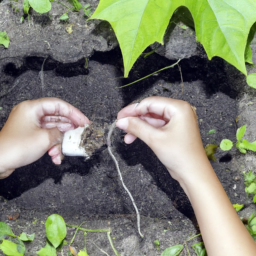Gardening Helping the Environment
How Gardening Helps The Environment
How Gardening Helps The Environment: A Comprehensive Guide
Gardening has been a popular pastime for centuries and its environmental benefits are growing increasingly evident. From reducing water and energy consumption to introducing plant diversity, there are a range of ways gardening can help the environment. Let's take a closer look at eight subtopics related to this important topic.
Features
Gardening can help our environment in a variety of ways, most notably by reducing water and energy consumption, conserving land, creating a habitat for wildlife, and reducing air pollution. To start, it can help conserve soil and water by preventing soil erosion from wind and rain, and controlling weeds. It also saves time and money by providing organic food directly from our own backyards, and reducing the need for expensive chemical based pest and weed killers. Furthermore, gardening can help reduce air pollution in cities by filtering particulate matter from the air. Finally, its purposeful green space can also help provide important habitats for wildlife, such as birds and insects.
Benefits
There are multiple benefits that can be critical for environmental facing gardens. To begin with, adding diversity and incorporating native plants can help boost our ecosystems' populations of pollenators, like bees, and aid in nutrient stabilization by reducing soil erosion. Additionally, gardens can help us build resilience and prepare for extreme weather shifts such as droughts, floods, hurricanes, and heat waves. Plantings also work to minimize heat transfers to cities and cooling costs for buildings since plants cool the air in hot temperatures whereas grass, foilage, and other plants can also help absorb heat, reducing the amount of cities with urban heat islands. Gardening also encourages healthy outcomes not only environmentally, but for people and their body, mind, and soul as it helps promote wellbeing and physical activity.
Pros & Cons
Gardening has both pros and cons when it comes to helping the environment. Pros include conserving water, removing air pollution, creating wildlife habitats, and providing natural dishes; while cons may include unknowingly introducing invasive and non-native species, nutrient runoff, and other misuses. However, as gardening becomes more popular, it is of utmost importance to educate oneself on the right techniques to help the environment in a positive way.
Case-Studies
To illustrate the benefits of gardening for the environment more concretely, let's take a look at three case-studies.
Edible Schoolyard Oakland: Established in the early 2000s, this one-acre organic garden & kitchen classroom provides Oakland, CA students with hands-on learning opportunities. Involving students in food production exposes them to the importance of environmental stewardship while inspiring a healthy diet.
Tuscon Community Gardens: Addressing both community development and environmental issues, Tucson, AZ community gardens are transforming disinvested neighborhoods into vibrant, sustainable, and productive communities. This provides them with healthy, low-cost housing, and job training, while inspiring behavior change.
Green Roofs for Healthy Cities: Installing vegetative gardens on buildings helps to save energy, reduce air pollution, filter and absorb stormwater, and create habitats for wildlife. The infrastructure of terraces, walls, and other features can create aesthetically-pleasing cities and more sustainable neighborhoods.
FAQs
Q: Why is gardening important for the environment?
A: Gardening is important for the environment because of its many benefits, including reducing water and energy consumption, conserving land, creating a habitat for wildlife, and reducing air pollution.
Q: What are some tips for successful gardening?
A: Some tips for successful gardening include planting in the right soil, understanding the sun exposure and irrigation needs of your plants, and being aware of your area's climate and weather patterns.
Q: What kind of plants are best for the environment?
A: The best plants for the environment are environmentally-friendly and native plants, as well as plants that produce their own natural fertilizer and can reproduce without additional chemicals and resources.
Q: What materials are needed for gardening?
A: The materials needed for gardening include soil, plants, irrigation equipment, compost, and tools such as hoes, shovels, and rakes.
Mistakes People Make
When gardening for environmental purposes, there are a few mistakes to avoid.
Choosing non-native species: Trying to accommodate an exotic or rare species can be tempting, but introducing and cultivating non-native species can lead to the destruction of our native plant life.
Over-watering: Too much water can lead to wasted resources, and is a common mistake when it comes to garden care.
Using harmful chemicals: Certain chemicals can add toxins to the environment, and should be avoided.
Best Practices
When it comes to gardening, there are several best practices that can help the environment.
Create natural pesticide barriers: Avoid using commercial, chemical pesticides whenever possible. Instead, create natural barriers, such as planting garlic or marigolds, or use homemade vinegar sprays with diluted lemon juice and citrus.
Incorporate compost: Compost is a valuable fertilizer as it retains moisture and is full of minerals and nutrients.
Practice water conservation: Plant water-efficient species, mulch your soil, and water with an efficient drip system or hand-held hose.
Conclusion
By learning the basics of gardening and taking on environmentally friendly practices, we can make a large impact on our planet. Gardening is a great way to make sustainable energy sources, create habitats for wildlife, and reduce air pollution. With knowledge of the features, benefits, pros & cons, case studies, FAQs, and best practices, you can become adept at gardening for the environment.
Final Notes
Gardening is an ancient practice for a modern purpose. With thoughtful design and consideration, we can create beautiful spaces that are good for the planet and ourselves. Whether it's a backyard herb garden or a vegetable garden, there are many ways to contribute to a healthier, more sustainable environment. Remember, sustainability starts with us.

Previous Page
Next Page
